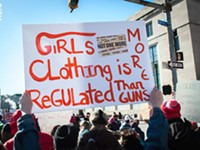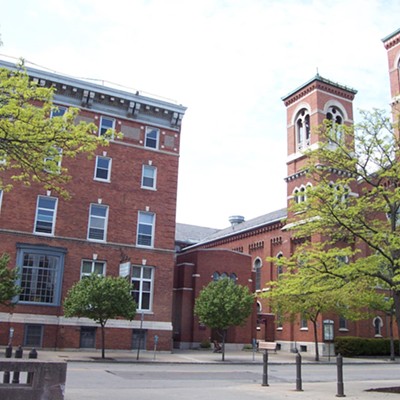[
{
"name": "500x250 Ad",
"insertPoint": "5",
"component": "15667920",
"parentWrapperClass": "",
"requiredCountToDisplay": "1"
}
]
A bullet has a life of its own. Sometimes even enough to drive journalists to lyricism.
Take this word-portrait by Los Angeles Times reporter Paul Dean: "The bullet left the heart, went into the left lung and exited... [The] slug stretched and displaced for milliseconds the heart muscles, valves, and chambers, forming what trauma surgeons know as the 'temporary cavity.' It created a temporary space the size of a baseball..."
The description ended with two exit wounds and a mute puddle of blood.
Dean was writing in 1990, and of course a lot of blood has flowed over the dam since then. Not that there hasn't been progress.
Indeed, things are getting a little better on the streets.
Like the Rochester streets.
Over the last decade, our annual total of homicides has declined substantially. The total for calendar 2002 was 41; in 1997, it was 61. There still are especially senseless tragedies, like that of LaTesha Parson, 13, an innocent bystander gunned down last year in a drive-by. But in his 1999 "State of the City" address, Mayor Bill Johnson could justly boast that 1998 was "the first [year] since 1990 that the city of Rochester experienced less than 50 homicides..."
Like any city, Rochester follows wider trends. And homicides throughout this society have followed a trajectory less immediately predictable than a bullet's.
A 2002 report from the federal Bureau of Justice Statistics tracks the ups and downs between 1976 and 2000. The US "homicide victimization" rate fell for most age brackets between 1980 and 1985. Then the rate climbed to a peak in the early 1990s. And then it fell off gradually (though during recent harder economic times, there's been an uptick).
But if you're calculating your chances of being a homicide victim, a lot depends on your age bracket. Young people, for example, accounted for most of the early 1990s spike in homicides, and 18-to-24-year-olds were far and away the most common homicide victims, with a rate of more than 25 per 100,000 population. That's around five times the rate for people age 50-plus during the same period. Moreover, the 50-plus group's victimization rate actually declined steadily, though not precipitously, between 1976 and 2000.
Then there's the rate of offending. Says the Bureau's report: "Eighteen to 24-year-olds have historically had the highest [homicide] offending rates, and their rates doubled from 1985 to 1993. Since 1993, offending rates for 18-to-24-year-olds have declined but remain higher than levels prior to the mid-1980s." But it was the 14-to-17-year-olds who stood out; their homicide offending rates, says the report, "exploded after 1985, surpassing the rates of 25-35-year-olds and 35-49-year-olds."
However you slice and dice the trajectories, you find little reason for comfort. Even though homicide rates have come down over the last decade or so, America has a serious homicide problem, and this or that city gets pinned with the "Murder Capital" label.
Why are the numbers so high, even when they've generally gotten lower?
People often remark that the United States is a violent country. That's unquestionable --- even if you exclude externalized homicide, for example, a long history of undeclared and, therefore, illegal wars and violent acts that have claimed millions of victims. But on the home front, is American society unusually or uniquely violent compared to the rest of the "developed" world?
Other industrialized nations have histories as violent as ours, or worse. Compare Germany in the 20th century. And though Americans seem addicted to violent entertainment, they're not alone. Nobody takes a backseat to the Japanese in that arena, for example. Not long ago, a Japanese film titled Ichi the Killer --- descended, by the way, from The Simpsons' "Itchy and Scratchy" sequences --- raised eyebrows when it was on the playbill of the Toronto Film Festival. "Extreme sado-masochist imagery abounds," said a Globe and Mail review, citing the ripping out of spinal cords and innards. Yet, says a 2001 report done for the UK Home Office (internal affairs in England and Wales), Japan's homicide rate from 1997 through 1999 was 1.04 per 100,000 population, compared to 6.26 in the US; and for further comparison's sake, 20.52 in Russia.
When you look at the rates of violent criminal activity overall, you find that the US is not necessarily out of line with other nations.
An initial caveat: International comparisons are notoriously difficult to make --- as are cross-jurisdictional comparisons within individual countries. The UK Home Office report put a finger on the central problem: "Definitions of offences vary between countries both due to legal differences and statistical recording methods." For that reason, the report focused on trends rather than absolutes.
Nonetheless, you can distill some meaningful impressions from the copious data that government agencies have gathered.
This is evident from a 1998 US Bureau of Justice Statistics study, Crime and Justice in the United States and in England and Wales, 1981-96, jointly authored by a Bureau statistician and a University of Cambridge scholar. Says the study: "Whether measured by surveys of crime victims or by police statistics, serious crime rates are not generally higher in the US than in England [and Wales]." In several categories, including robbery, assault, and burglary, the rates in England-Wales were actually higher, the study says.
But the study also found that trends here versus there have been quite different: For example, according to one chart, the two countries had about the same rate for assault in the early 1980s, in the 10-12 range per 1,000 population. But the US assault rate was tracking generally downward during the 1980s and 1990s, while the rate in England-Wales was climbing. The stats for robbery showed similar tendencies. During the period studied, the robbery rates in both the US and England-Wales hovered between four and seven per 1,000 population. But neither country was static; their rate-paths crossed in the early 1990s near the 6-per-1,000 mark, with the US rate heading downward and the England-Wales rate going up.
The UK Home Office study, which compared countries as far-flung as South Africa and Austria, found the same kind of thing when comparing violent-crime rates in the US and Canada. In 1999, for example, the US total of "violence against the person, robbery, and sexual offences" came to 1,430,690. In Canada, the total was 291,330. Adjusted for population, both countries had rates below one percent, though the US rate was higher --- probably too slippery in any case for statistical certainty. The rates in both countries also had headed downward during the late 1990s, by a greater degree in the US than in Canada.
Such figures and trends seem to give the lie to a point made in Michael Moore's film Bowling for Columbine: that Canadians may be more civil than we are. They certainly may be more progressive politically, per capita. But are they inherently nicer? (And was Moore's point another instance of cultural stereotyping of Canadians, albeit a well-meant one?) The same questions must be raised for the English and Welsh versus Americans.
But there's one category in which Americans truly "excel."
It's homicide; in particular, the sub-category of gun homicide.
"The major exception to the pattern of higher crime rates in England is the murder rate," says the Bureau of Justice Statistics report. "The 1996 US murder rate [was] vastly higher, nearly six times, than England's, although the difference between the two nations has narrowed..."
Why? The report gives one big reason: "Firearms are more often involved in violent crimes in the US than in England. According to 1996 police statistics, firearms were used in 68 percent of US murders but seven percent of English murders, and 41 percent of US robberies but five percent of English robberies."
The Washington-based Violence Policy Center did a study last year of firearm mortality rates in 11 countries. Not surprisingly, the US was on top, with an overall firearm death rate of 13.7 per 100,000 population, versus 3.9 percent in Canada, 4.3 percent in Norway, 2.9 percent in Australia, and just 0.4 percent in England-Wales. Of course, guns, and particularly handguns, are strictly controlled in the UK --- and only four percent of households possess firearms, versus more than 40 percent of households in the US.
What about our closest neighbor, Canada, with which we share the "myth of the frontier" and other ambiguous legacies? In Bowling for Columbine, director Moore said Canadians own more guns than Americans do proportionally. They certainly do own a lot of them. But Canada's Coalition for Gun Control, using US and Canadian government information, says that in 1998, the rate north of the border was 0.25 guns per capita versus 0.82 per capita in the States. And there's a more important angle. The vast majority of guns in Canada, a nation with many isolated communities and subsistence as well as sport hunters, are rifles and shotguns.
In regard to handguns --- the category most directly related to crimes against persons --- the gulf between Canada and the US is wider and deeper than Lake Superior. According to the Coalition for Gun Control, Canada has 1.2 million handguns; the US has 76 million. (The US is also an inordinately large producer of handguns, which, as Naomi Seligman of the Violence Policy Center says, are not covered by any consumer safety regulations.)
Here's the Coalition's conclusion: "Canada has always had stronger firearms regulation than the US, particularly with respect to handguns. In Canada, handguns have been licensed and registered since the 1930s, ownership of guns has never been regarded as a right, and several court rulings have reaffirmed the right of the government to protect citizens from guns. Handgun ownership has been restricted to police, members of gun clubs, or collectors. Very few --- about 50 in the country --- have been given permits to carry handguns for 'self-protection.' This is possible only if an applicant can prove that their life is in danger and the police cannot protect [them]."
Similar restrictions apply in the UK. Moreover, Canada just enacted tighter controls over hunting weapons, with the aim of registering every firearm in the land. The new legislation, though, has provisions for provincial "opt-out," and Canada does have its own gun lobby, so the last chapter on this hasn't been written.
It seems most advanced nations have taken a supply-side approach: Limit the number of guns in the society and thus limit the mayhem angry, violent, desperate people can do to others. (And to themselves: Seligman says that around 17,000 of America's almost 30,000 annual gun deaths are suicides.)
Rochester Institute of Technology criminologist John Klofas, studying local homicides in 2000-2001, found that half of them were the result of "disputes" --- "straight-out arguments," he says. Klofas notes, too, that nearly 70 percent of Rochester homicides have involved guns. Moreover, he found in focus groups that a large number of people in some high-homicide neighborhoods, perhaps a majority, have been carrying guns, mostly "for protection."
The local data point to another problem: the occurrence of gun crimes in our cities. And here again, comparative data can be fatal to our self-perceptions. For example, says the UK Home Office report, London, fabled home of soccer hooligans, suffered 190 homicides in 1999; that same year, the much smaller Washington DC had 241 homicides. And Washington's total had steeply declined during the late 1990s.
With guns so prevalent, and human nature so volatile, Columbine-style massacres almost have to occur. But what will be the national response? A good movie followed by National Rifle Association sniping and legislators diving for cover?
It's significant that Canada's recent moves toward greater control came after the infamous 1989 "Montreal Massacre," in which a crazed misogynist shot 14 women dead at the University of Montreal's Ecole polytechnique. Similarly, the British tightened up further after the 1996 Dunblane Massacre (16 dead). And other nations, including Australia, have responded appropriately to gun massacres of their own.
So which will come first, America's response or the next Columbine?
Speaking of Gun Control
-

Feedback 8/21
Aug 21, 2019 -

Adults fail on gun control; children pay the price
May 14, 2019 -

Feedback 3/14
Mar 14, 2018 - More »
Latest in News
More by Jack Bradigan Spula
-

The state of Main
Apr 14, 2004 -
School improvement: the price is wrought
Apr 7, 2004 -
Hour of power
Mar 31, 2004 - More »






